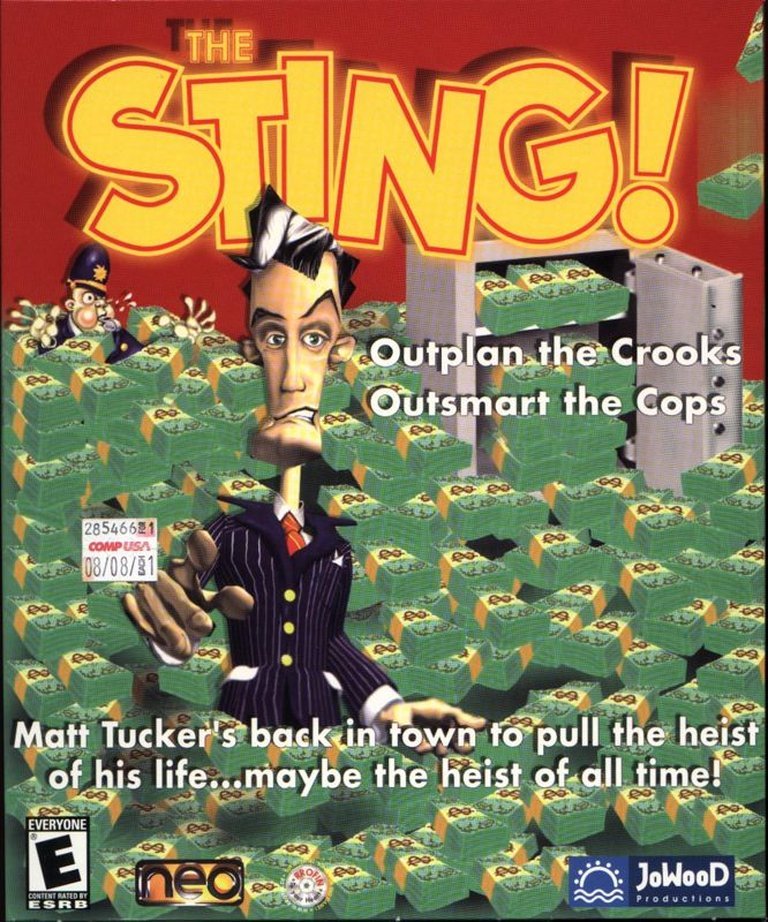- Release Year: 2001
- Platforms: Windows
- Publisher: 1C Company, JoWooD Productions Software AG, Snowball.ru
- Developer: neo Software Produktions GmbH
- Genre: Action, Simulation
- Perspective: 3rd-person
- Game Mode: Single-player
- Gameplay: Puzzle elements
- Setting: Crime
- Average Score: 72/100

Description
The Sting! is a crime simulator where you play as Matt Tucker, a master thief who has just been released from prison. The game involves scouting locations, planning heists with various accomplices and tools, and executing the plans in a 3D city environment with puzzle elements and action gameplay.
Gameplay Videos
Where to Buy The Sting!
PC
Reviews & Reception
en.wikipedia.org (73/100): Most of the reviewers praised the light-hearted tone of the game and the unique theme of it.
mobygames.com (68/100): Matt Tucker became famous as a master criminal, he was good at breaking and entering and others knew this too.
ign.com (75/100): A quirky little burglary game that just put a smile on my face despite its little problems.
squakenet.com : A fantastic burglary sim
The Sting!: Review
Introduction
“The Sting!” is a unique blend of strategy and adventure that plunges players into the world of burglary simulation. Developed by neo Software and published by JoWooD Productions in 2001, it is the sequel to the 1994 game “The Clue!”. This review will dissect the game’s development history, narrative, gameplay mechanics, world-building, reception, and legacy, providing a comprehensive analysis of its place in video game history.
Development History & Context
“The Sting!” was developed by neo Software Produktions GmbH, an Austrian game development studio, and published by JoWooD Productions Software AG. The game was released on March 29, 2001, for Windows. At the time, the gaming landscape was dominated by 3D graphics and immersive storytelling. “The Sting!” stood out with its cartoonish, 3D visuals and innovative gameplay mechanics.
The development team, led by producers like Hannes Seifert and game designers Erwin Kloibhofer and Hannes Seifert, aimed to enhance the gameplay of “The Clue!” with 3D graphics and more complex planning mechanics. The game’s technical constraints were notable, with the developers utilizing Direct3D 7 and ensuring compatibility with a range of hardware configurations.
Narrative & Thematic Deep Dive
The game follows Matt Tucker, a master burglar released from prison after serving time for his past crimes. The narrative is set in the city of Fortune Hills, where Matt must rebuild his reputation by planning and executing heists. The story is relatively straightforward, with Matt progressing from small-time crook to a renowned burglar, ultimately targeting the mysterious Ministry of Light.
The game’s thematic focus on burglary and crime is handled with a light-hearted tone, emphasizing strategy and planning over violence or gore. This approach allows players to engage with the game’s world without being exposed to mature themes.
Gameplay Mechanics & Systems
“The Sting!” is characterized by its unique blend of exploration, planning, and execution phases. Players must scout locations, recruit accomplices, and plan heists in detail before executing them. The gameplay is divided into three main phases: initial scouting, planning, and execution.
- Initial Scouting: Players explore the city, identifying potential targets and gathering information.
- Planning: In Matt’s apartment, players plan the heist, selecting targets, getaway vehicles, accomplices, and tools. The planning phase utilizes a VCR-like interface, allowing players to record and adjust their plans.
- Execution: The planned heist is executed, with the player watching as their characters carry out the scripted actions.
The game’s mechanics emphasize strategy and timing, with players needing to balance the use of different tools and accomplices to succeed. The sound design and visual cues play a crucial role in alerting players to potential risks, such as guards or alarm systems.
World-Building, Art & Sound
The game’s world, Fortune Hills, is rendered in 3D with a distinctive cartoonish style. The art direction is characterized by exaggerated character designs and vibrant, though sometimes dark, environments. The 3D graphics, while not cutting-edge at the time of release, provided a visually engaging backdrop for the gameplay.
The sound design is functional, with sound effects and music contributing to the game’s atmosphere. The soundtrack is not particularly memorable but fits the game’s tone.
Reception & Legacy
“The Sting!” received mixed reviews upon release, with an average score of 68% on MobyGames based on 20 critic reviews. Reviewers praised the game’s unique concept and engaging gameplay but criticized its sometimes clunky interface and lack of penalty for failure.
Despite these criticisms, “The Sting!” has maintained a dedicated following and is remembered fondly for its innovative gameplay mechanics. It has not had a direct sequel but remains a cult classic within the strategy and adventure genres.
Conclusion
“The Sting!” is a standout title in the strategy and adventure genres, offering a unique blend of planning and execution that sets it apart from other games of its time. While it has its flaws, the game’s engaging gameplay and memorable world make it a worthwhile experience for players looking for a challenging and strategic game. Its legacy continues to be celebrated by fans of niche and innovative games, ensuring its place in video game history.